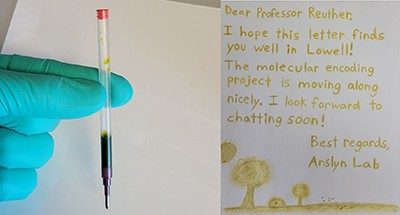FOR IMMEDIATE RELEASE | July 20, 2022
‘Pulling back the curtain’ to reveal a molecular key to The Wizard of Oz
“Molecular Encryption and Steganography Using Mixtures of Simultaneously Sequenced, Sequence-Defined Oligourethanes”
ACS Central Science
Many people and companies worry about sensitive data getting hacked, so encrypting files with digital keys has become more commonplace. Now, researchers reporting in ACS Central Science have developed a durable molecular encryption key from sequence-defined polymers that are built and deconstructed in a sequential way. They hid their molecular key in the ink of a letter, which was mailed and then used to decrypt a file with text from The Wonderful Wizard of Oz.
Securely sharing data relies on encryption algorithms that jumble up the information and only reveal it when the correct code or digital encryption key is used. Researchers have been developing molecular strategies, including DNA chains and polymers, to durably store and transport encryption keys. Currently, nucleic acids store more information than polymers. The challenge with polymers is that when they get too long, storing more data with each additional monomer becomes less efficient, and figuring out the information they’re hiding with analytical instruments becomes extremely difficult. Recently, Eric Anslyn and colleagues developed a method to deconstruct polymers in a sequential way, allowing their structures to be determined more easily with liquid chromatography-mass spectrometry (LC/MS). So, Anslyn, James Ruether and others wanted to test the method on a mixture of unique polymers hidden in ink to see if the approach could be used to reveal a complex molecular encryption key.
First, the researchers generated a 256-character-long binary key that could encrypt and decrypt text files when entered into an algorithm. Next, they encoded the key into polymer sequences of eight 10-monomer-long oligourethanes. Only the middle eight monomers held the key, and the two ends acted as placeholders for synthesis and decoding. The decoding placeholder was a unique, isotopically labeled “fingerprint” monomer in each sequence, indicating where each polymer’s encoded information fit in the order of the final digital key. Then the researchers mixed the eight polymers together and used a sequential depolymerization method and LC/MS to determine the original structures and the digital key. Finally, one group of the researchers combined the polymers with isopropanol, glycerol and soot to make an ink, which they used to write a letter that they mailed to other colleagues, who didn’t know the encoded information. These scientists extracted the ink from the paper and followed the same sequential analysis to successfully reconstruct the binary key. They entered the encryption key into the algorithm, revealing a plain text file of The Wonderful Wizard of Oz. The researchers say that their results demonstrate that molecular information encryption with sequence-defined polymer mixtures is durable enough for real-world applications, such as hiding secret messages in letters and plastic objects.
The authors acknowledge funding from the Army Research Office, the Howard Hughes Medical Institute, the Keck Foundation and the Welch Reagents Chair.
For more of the latest research news, register for our upcoming meeting, ACS Fall 2022. Journalists and public information officers are encouraged to apply for complimentary press registration by completing this form.
To automatically receive press releases from the American Chemical Society, contact newsroom@acs.org.
Note: ACS does not conduct research, but publishes and publicizes peer-reviewed scientific studies.
Media Contact
ACS Newsroom
newsroom@acs.org

View larger image

